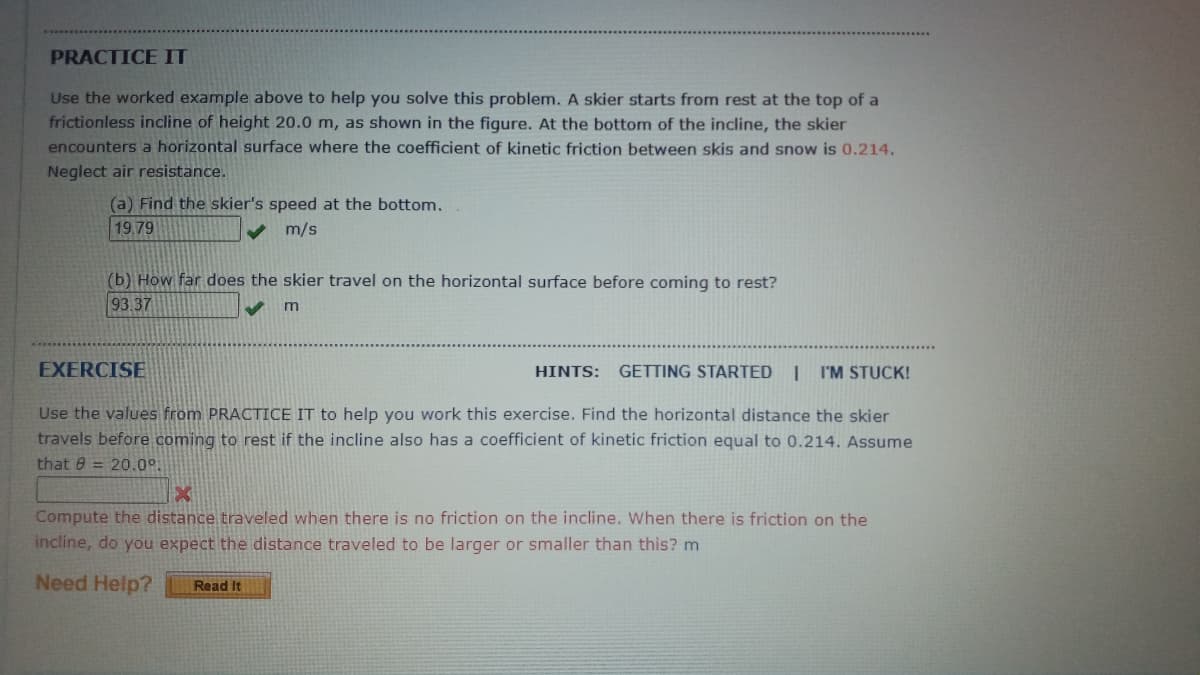PRACTICE IT Use the worked example above to help you solve this problem. A skier starts from rest at the top of a frictionless incline of height 20.0 m, as shown in the figure. At the bottom of the incline, the skier encounters a horizontal surface where the coefficient of kinetic friction between skis and snow is 0.214. Neglect air resistance. (a) Find the skier's speed at the bottom. 19.79 m/s (b) How far does the skier travel on the horizontal surface before coming to rest? 93.37 EXERCISE HINTS: GETTING STARTED I I'M STUCK! Use the values from PRACTICE IT to help you work this exercise. Find the horizontal distance the skier travels before coming to rest if the incline also has a coefficient of kinetic friction equal to 0.214. Assume that 0 = 20.0°. Compute the distance traveled when there is no friction on the incline. When there is friction on the incline, do you expect the distance traveled to be larger or smaller than this? m Need Help? Read It
PRACTICE IT Use the worked example above to help you solve this problem. A skier starts from rest at the top of a frictionless incline of height 20.0 m, as shown in the figure. At the bottom of the incline, the skier encounters a horizontal surface where the coefficient of kinetic friction between skis and snow is 0.214. Neglect air resistance. (a) Find the skier's speed at the bottom. 19.79 m/s (b) How far does the skier travel on the horizontal surface before coming to rest? 93.37 EXERCISE HINTS: GETTING STARTED I I'M STUCK! Use the values from PRACTICE IT to help you work this exercise. Find the horizontal distance the skier travels before coming to rest if the incline also has a coefficient of kinetic friction equal to 0.214. Assume that 0 = 20.0°. Compute the distance traveled when there is no friction on the incline. When there is friction on the incline, do you expect the distance traveled to be larger or smaller than this? m Need Help? Read It
University Physics Volume 1
18th Edition
ISBN:9781938168277
Author:William Moebs, Samuel J. Ling, Jeff Sanny
Publisher:William Moebs, Samuel J. Ling, Jeff Sanny
Chapter6: Applications Of Newton's Laws
Section: Chapter Questions
Problem 63P: The contestant now pulls the block of ice with a rope over his shoulder at the same angle above the...
Related questions
Question
I need help with the exercise part please

Transcribed Image Text:PRACTICE IT
Use the worked example above to help you solve this problem. A skier starts from rest at the top of a
frictionless incline of height 20.0 m, as shown in the figure. At the bottom of the incline, the skier
encounters a horizontal surface where the coefficient of kinetic friction between skis and snow is 0.214.
Neglect air resistance.
(a) Find the skier's speed at the bottom.
19.79
m/s
(b) How far does the skier travel on the horizontal surface before coming to rest?
93.37
m
EXERCISE
HINTS: GETTING STARTED I I'M STUCK!
Use the values from PRACTICE IT to help you work this exercise. Find the horizontal distance the skier
travels before coming to rest if the incline also has a coefficient of kinetic friction equal to 0.214. Assume
that 0 = 20.09.
Compute the distance traveled when there is no friction on the incline. When there is friction on the
incline, do you expect the distance traveled to be larger or smaller than this? m
Need Help?
Read It
Expert Solution
This question has been solved!
Explore an expertly crafted, step-by-step solution for a thorough understanding of key concepts.
This is a popular solution!
Trending now
This is a popular solution!
Step by step
Solved in 2 steps with 2 images

Knowledge Booster
Learn more about
Need a deep-dive on the concept behind this application? Look no further. Learn more about this topic, physics and related others by exploring similar questions and additional content below.Recommended textbooks for you

University Physics Volume 1
Physics
ISBN:
9781938168277
Author:
William Moebs, Samuel J. Ling, Jeff Sanny
Publisher:
OpenStax - Rice University

University Physics Volume 1
Physics
ISBN:
9781938168277
Author:
William Moebs, Samuel J. Ling, Jeff Sanny
Publisher:
OpenStax - Rice University